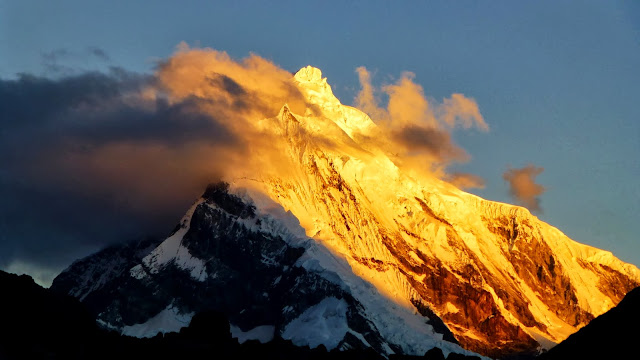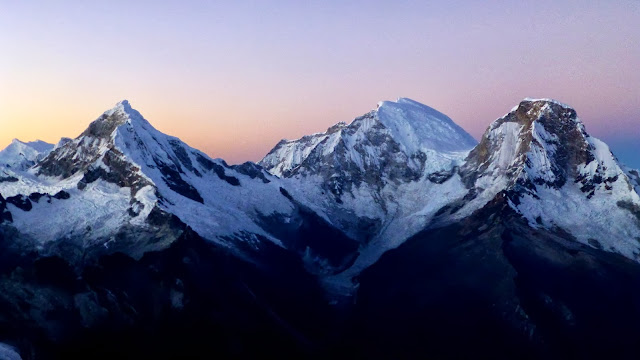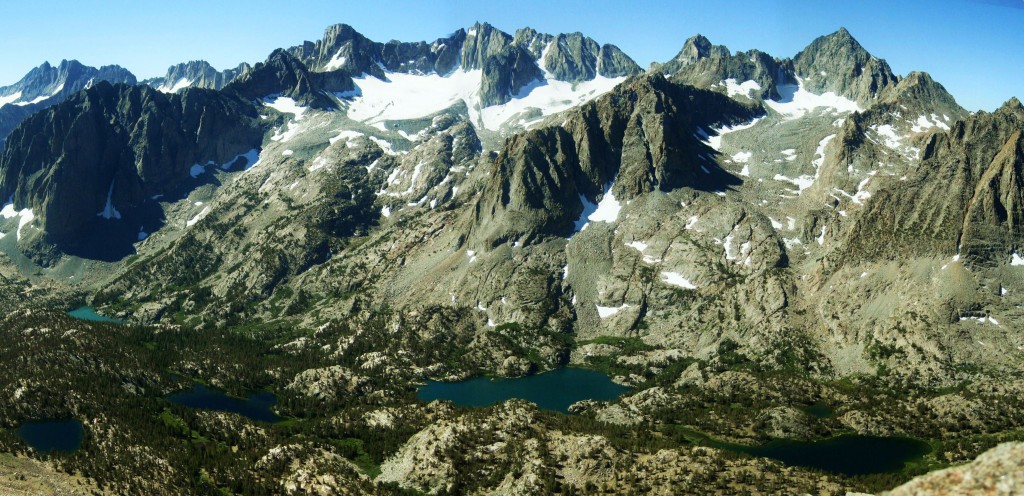Chacraraju Este (6,001 M / 19,688 ft), like Alpamayo, is a striking peak in Cordillera Blanca. But unlike Alpamayo it is a peak which sees only few attempts per year, if any, most of which end up being just that - attempts. The Research I did before our trip showed not much reason to be optimistic. The first report I found about an attempt at 'Jaeger route' (our route of choice) was named "Paralysed in Peru - Accident on Chacraraju." Second, was a youtube video from a sponsored German team, at the end of which the climbers complained about terrible conditions of corniced summit ridge. Third article I found, was from a well-known British pro-climber Nick Bullock. In 20 hours, tent to tent he and his partner established a new 'three-pitch direct variation' to Jaeger route but stated, "The summit was not climbed to, as life appeared more favorable." A few days after our adventure on Chacraraju Este I am sure our life appeared much more favorable than getting to the the peak, but being too stubborn deserves the credit for not calling it quits. The last 200 vertical feet took us close to four hours - we burrowed through sugar snow, fought hollow ice, attempted to aid a summit cornice with pickets, and used every possible trick we could think of before we reached the top in a complete white-out. This time the views were slim to none, but excitement, oh no, the FEAR was high - we still had to rapell from the unconsolidated and overhanging summit cornice, off of a single picket, create a dozen or so v-threads to abseil back down to a glacier in a white-out, and find our way down to our camp 2000 ft below - hiking through flurries of snow on unstable talus.
 |
| Summit ridge on Chacraraju Este - at dawn |
 |
| Laguna Chinancocha - yes it was really that beautiful |
 |
| South Face of Chacraraju Oeste and Este |
Every journey begins with some rest. Our post Quitaraju/Alpamayo rest was in Hatun Machay. We spent four days clipping bolts and "crushing gnar with our bros." By modern sport climbing standarts not "crushing" at all, but I was excited to onsight or red-point six 5.11As in first two days, which for me is good news. Mountain diet made up of Oreos must be working well, no matter how many I eat, my waist line shrinks. I was most excited about onsighting two of the area's 3/3 star 5.11As - "Welcome to Huaraz," and "Fancy a Good Route." The final sequence of the latter was one of the coolest finishes to any climb I have ever done - technical but at the same time powerful. Even Hamik was impressed with the finish and happy to get the onsight of this route. In addition to climbing rock, again, I hiked up a 4,800 M peak a few times to help my body acclimate. After the first couple of days my skin got worked and I was happy to do easier routes and some pull-ups back at the guest house. Quite funny, but our first mini epic of our trip happened on the way back from Hatun Machay - we barely escaped a shiver bivy and got picked up by a 'collectivo' (fun way to travel around) thirty minutes before sunset. This time we waited for a ride for close to two hours. Leave the hut earlier than 3pm, lesson learned!
 |
| On one of awesome 5.11s |
 |
| It snowed in Hatun Machay! |
 |
| "Welcome to Huaraz" - monkeys are sendin |
 |
| Super happy about getting the onsight |
 |
| Some South Americans at the hut had a hallucinogen party |
 |
| This flower looked so cool, I thought it was fake at first |
When we got back to Huaraz, bought supplies for our alpine outing, and arranged our transportation, most of the local people were surprised to hear we were going to attempt Chacraraju - "No one climbs that peak, it is hard!" The worker at an entrance station to Huascaran National Park even tried to talk us out of attempting it! Cherry on top was a British guy we met at Laguna 69 - "Two climbers tried to climb it, but both died." My eyes bulged out in disbelief, but out of courtesy I kept my mouth shut. Some people are great (not really) at being supportive.
 |
| River on the approach |
 |
| Chacraraju Oeste at sunset |
 |
| Summit cornice on Chacraraju Oeste |
 |
| Annoying cow at Laguna 69 |
One of several positive things about attempting Chacraraju Este is a relatively short approach and a beautiful camp site. We took full advantage of our position and camped on shores of Laguna 69 for four nights. This area is famous for its scenery and attracts a myriad of tourists from Western world. The few negative things include an annoying cow that would wake us up at least a few times per night, and no trail through the glacier. Since Chacraraju does not draw crowds two Californians with limited glacier-travel experience had to navigate through a sea of giant crevasses and snow that at times was up to our hips. To my surprise, we did a good job and finished our outing with no crevasse falls or reached dead ends. Crux of this approach came when I was breaking trail through deep snow and started sinking a bit too deep for my liking. Turned out it was because there was a giant crevasse beneath me. After getting out and digging through several feet of fresh snow I found a solid snow bridge and overcame the problem.
 |
| Another cool flower |
 |
| Laguna 69 - water is unbelievably clear |
 |
| View of Chopicalqui with a lenticular cloud (right from our camp) |
 |
| Chacraraju Oeste (left) and Este (right) |
From below our route of choice looked fairly straight forward and we were quite surprised it was rated ED1. On overall difficulty rating of mountain routes ED is considered serious business. Difficulty rating goes from Facile (F) - easy, PD - a little difficult (DC on Rainier, West Buttress on Denali and other walk-ups on big peaks), AD - fairly difficult (Matterhorn, Hornli Ridge or East Face of Mt. Whitney), D - Difficult (North Buttress of Slesse, or NE ridge of Bugaboo Spire), TD - Very Difficult (Beckey-Chouinard on South Howser Tower, Harding Route on Keeler Needle) and ED stands for extremely difficult and closes the rating system. For example, North Face of the Eiger is rated ED2. Difficulties we could not spot from the bottom were found close to the top.
 |
| Chopicalqui at sunset |
 |
| South Face of Chacraraju Este |
 |
| View of a small waterfall at Laguna 69 |
 |
| View of Laguna 69 from above |
With no clouds and sky full of stars we left our tent thirty minutes past midnight. Having done the approach most of the way up the glacier on the day prior we cut our time by couple of hours. A team of three climbers from Chile repaid us a favor and picked up our work. They broke trail all the way to the bergshrund, which saved us time and energy. They camped on the glacier and we were surprised they did not get on the route earlier than us. We simul-climbed or soloed majority of the route with occasional picket or ice screw placement between us. After about six blocks of that we pitched out several pitches due to more complex climbing than we were willing to simul. The climbing ranged from solid blue ice to one centimeter of ice over loose rock, and traverses over spines of vertical powder. It was quite different from anything I have ever encountered in the mountains. This was no Sierra Nevada!
 |
| Chacraraju Oeste - another majestic and extremely difficult peak - a step up |
 |
| Finding our way through the glacier |
 |
| Hamik with NE face of Huandoy Sur in the background |
 |
| Great looking snow bridge (breaking trail day) |
 |
| Resting back in the tent - views are not bad |
 |
| Top portion of Chacraraju Este's South Face (crux of our climb) |
The climbing community often debates over "do summits matter?" question. Even though it is quite silly to ask, it produces a variety of valid points from both sides of the argument. For me this question has a variety of answers in different situations. On Chacraraju Este, the summit mattered beyond any doubt. After I finished a pitch and built a solid belay station bellow the summit ridge, Hamik took the next lead and traversed left bellow the summit cornice. By summit cornice I mean something that looks like a snow and ice castle of an evil villain in a fairy tale. With increased difficulties of our climb, the weather changed too. Clear day turned cloudy and by the time Hamik was half way done with the pitch we were in a white out. This traverse took a long time as he tried to burrow through the cornice at it's low point and use every trick up his sleeve to scale the summit ridge. When he was unable to climb up it, he tried to aid it with pickets which didn't quite work with sugar snow dumping on him every time he tried to make an axe placement, or put in a picket. After he traversed a rope-length left and made a DNF belay anchor, I understood why it took so long to complete the pitch when I began to follow.
 |
| As psyched as it gets at 12:30am |
 |
| Above the clowds (about 500 ft up on our route) |
 |
| Angle on first half of the face with weird snow formations |
 |
| Chopicalqui, Huascaran Sur, and Norte at dawn |
 |
| Rock slabs covered in thin sheet of ice higher up on route |
Traversing below a cornice which at times was overhanging and pushing me off balance, majority of my foot placements were in unconsolidated powder snow which collapsed under my weight. Some sections we passed required more prayer than skill, making run-out WI5 climbing feel like child's play. I attempted to aid a section Hamik gave up on, but also had no luck. Every time I tried to place something above our solid picket I got a face full of snow. When I got to the belay he told me about an epic fall he suffered while attempting to aid it. Thank god I did not see it, and could not feel it neither since he fell directly on to the picket while still being connected to it. At the crux of the traverse I had to down-climb ten feet and another 40 feet left to the next placement - an ice screw in a rare block of ice. Falling here would be a disaster. With 30 foot ice hangers below, powder gargoyles all around, minimal visibility, and a cornice pushing down on me, it took a lot of mental strength to piece together a sequence to the belay. At one point I was on an actually overhanging section with less than solid ice tool placements and feet scratching for placements in sugar. When I got up to our belay, I forgot about the amount of time it took Hamik to climb these 60 meters, all I could say was "good lead."
 |
| Chopicalqui, and Huascarans during sunset. Incredible view. |
 |
| Hamik climbing on Jaeger Route |
 |
| Above the clouds! |
 |
| Chopicalqui is a peak I would love to climb! |
 |
| Me following a traverse high on the face (photo by Hamik M.) |
With my eyes still bulged, I saw our last hurdle. It was finally possible to mount the summit cornice and traverse back right to the summit. Final encouragement from Hamik was - "if you feel like you are falling, make sure to fall to the north." "Thanks buddy, that helped." I stomped a starting platform and cleared a foot of fresh snow from the top to get some purchase. At first I crawled, using both my axes to balance my body from peeling off into unknown. Than it got wider and I was able to get up and walk with caution. I went up another hill and realized it was the high point of the ridge. Shouting with joy I belayed Hamik up. Yells of joy ended after a summit photo and a game of rock, paper, scissors. This time we were not playing for who will eat a chocolate bar, but who would rappell from a backed up picket. Even though I won this game, chances of a picket vertically buried in powder snow holding a fall were not encouraging. I buried our main anchor as a T-slot (horizontally), said a small prayer and went over the lip. It held for both of us.
 |
| View of Chacraraju Oeste and summit ridge (photo by Hamik M.) |
 |
| Excited to be on top! |
 |
| White-out on summit ridge (Chacraraju Este) |
 |
| Hamik rappelling from an overhanging summit cornice. Wildest rap of our lives! |
 |
| Hamik on one of our raps |
 |
| V-thread backed up with a screw |
With hours of day-light fading we started rappelling our route. Making V-threads for most of our anchors we developed a good system with Hamik constructing and me dealing with rope. We were able to thread the rope directly through our V-threads and leave no tat on the mountain. The only 'booty' we left were three pickets. Our system worked smoothly and we were able to rap the majority of south face in day-light. As we got lower down it started to snow, but visibility slightly increased. As we got closer to the bergshrund we saw the lights from Chileans camping on the glacier and realized we were getting closer to safety. We down-climbed last 100 meters of 55 degree snow and made our way to say "hello" to our new friends. They passed us a tasty drink and seemed sincerely happy about us summiting - "it is extremely rare for anyone to summit Chacraraju, you are first this year." With our primitive Spanish and their limited English we spoke about climbing, shitty weather, and food before hiking about 2000 ft down to our camp at Laguna 69. Twenty two hours after we started our journey we got back to camp, unfortunately to find our tent soaked by melting snow. I devoured a pack of top ramen and passed out. Unfortunately, as we packed our camp we saw the climbers from Chile descending back down from glacier camp, due to weather without making an attempt to climb. I hope they have more food and time to make another attempt at the route.
 |
| This flower was tiny |
 |
| First cactus of this kind that I saw blossom |
 |
| Huandoy seen from the valley - a giant face |
 |
| AND I finally gathered courage to eat CUY! (guinea pig) |
On our way back to Huaraz we met many other people, including a group of Austrian tourists who offered us a ride to Yungay. Making it back to our hotel before sunset was a treat, this time we were able to get out and celebrate our climb with a good meal (two meals and two cones of ice cream in my case). Relaxing in Huaraz is great, but there is more rock climbing to be done. 'The Sphynx' is calling! I'm psyched to make it out to Paron Valley.




